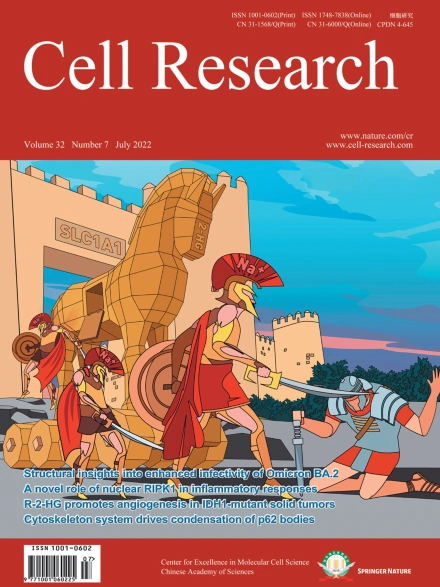
Advanced Search
Submit Manuscript
Advanced Search
Submit Manuscript
Volume 32, No 7, Jul 2022
ISSN: 1001-0602
EISSN: 1748-7838 2018
impact factor 17.848*
(Clarivate Analytics, 2019)
Volume 32 Issue 7, July 2022: 687-690 |
The structure of erastin-bound xCT–4F2hc complex reveals molecular mechanisms underlying erastin-induced ferroptosis
Renhong Yan1,8,† , Enjun Xie2,3,† , Yaning Li4,† , Jin Li2,3,† , Yuanyuan Zhang1 , Ximin Chi1 , Xueping Hu5 , Lei Xu6 , Tingjun Hou5 , Brent R. Stockwell7 , Junxia Min2,* , Qiang Zhou1,* , Fudi Wang2,3,*
1Westlake Laboratory of Life Sciences and Biomedicine, Key Laboratory of Structural Biology of Zhejiang Province, Institute of Biology, Westlake Institute for Advanced Study, School of Life Sciences, Westlake University, Hangzhou, Zhejiang, ChinaDear Editor,
Ferroptosis is an iron-dependent, non-apoptotic form of regulated cell death characterized by an accumulation of lipid- derived reactive oxygen species (ROS). The small-molecule compound erastin induces ferroptosis via inhibiting the cystine-glutamate antiporter system xc–, which consists of two subunits, namely the light chain xCT and the heavy chain 4F2hc (encoded by the SLC7A11 and SLC3A2 genes, respectively).1,2,3,4 Recent studies have shown that xCT (SLC7A11) regulates ferroptosis in liver fibrosis, cardiomyopathy, and numerous other pathophysiological processes.5,6,7,8 The complex formed by xCT and 4F2hc has also been suggested as a possible therapeutic target for cancer, as it is overexpressed in a wide variety of cancer types; moreover, inhibiting xCT impairs cystine uptake, causing an accumulation of ROS and suppressing tumor growth.9,10 However, the underlying molecular mechanisms remain unknown. Here, we overexpressed and then co-purified human xCT and 4F2hc, finding that they form a stable complex (Fig. 1a). To test whether this purified complex is functional, we then reconstituted the complex into liposomes and performed a counter-flow assay. We found that the wild-type (WT) xCT–4F2hc complex mediates the exchange of cystine and glutamate — measured as the uptake of 14C-labeled cystine — and this activity was significantly reduced by the system xc– inhibitors, erastin and sulfasalazine (Supplementary information, Fig. S1).
https://doi.org/10.1038/s41422-022-00642-w